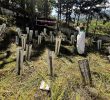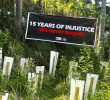REGIONAL OVERVIEWS: ASIA-PACIFIC
2006 was a year of dramatic events and much change in Asia and the Pacific. Political upheavals provided the context for accounts of fear, deprivation and discrimination. These included political unrest in Timor-Leste, Tonga and the Solomon Islands, and the declaration of a state of emergency in the Philippines that sparked fears of increased political killings.
In Bangladesh, politically motivated violence marred the run-up to delayed elections, and in Myanmar the authorities continued their policy of incarceration and repression of political opposition. Sri Lankan peace talks collapsed and a ceasefire barely held; thousands of killings and mass displacement occurred through the year and in November the ceasefire was declared �defunct� by the opposition armed group Liberation Tigers of Tamil Eelam (LTTE). Coups took place in Thailand and Fiji. Alongside the anxiety, suffering and despair was hope and opportunity in Nepal where, after years of conflict and political stalemate, people came together to demand peace, human rights and democratic transition. Their voices were heard and the opportunity for peaceful transition appeared to have been seized when the King and political parties agreed a way forward that saw a comprehensive peace agreement signed in November.
The Asia-Pacific region is home to six of the 10 most populous states in the world, and alone they account for half the world�s people. Several events in 2006 reflected the region�s growing role on the world stage. China�s global commercial and political influence grew, and its preparations for the 2008 summer Olympic games, generated a climate of pride and some debate. Viet Nam was set to become the World Trade Organization�s (WTO�s) 150th member in January 2007 after its membership was approved by the WTO�s General Council in late 2006. A South Korean, Ban Ki-Moon, was chosen to be the next UN Secretary-General.
In terms of human rights developments, governments� words and deeds were not always well matched. Ten countries in the region joined the new UN Human Rights Council and made admirable statements on human rights. The Association of Southeast Asian Nations (ASEAN) took steps towards a greater role for human rights in its work. However, Asia and the Pacific remained alone in having no regional human rights mechanism, and on the ground improvements in human rights protections were patchy.
GLOBALIZATION: PROSPERITY, POVERTY AND MIGRATION
Globalization continued to have a profound impact in the region. China and India in particular notched up envied rates of economic growth while strengthening their economic ties with each other. However, such developments did not bring benefits to everyone. Some industrialization and development projects brought displacement and human rights abuses, and millions of the most disadvantaged people remained in poverty as the benefits of development were enjoyed disproportionately by those better educated, housed and skilled. According to the UN, more than 28 per cent of people in India remained below the national poverty line. The figures were 50 per cent in Bangladesh, 40 per cent in Mongolia and 33 per cent in Pakistan.
In particular, the rural-urban divide meant that economic development had yet to have a positive effect on the lives of many rural populations. In India, for example, overall unemployment increased, despite the booming service sector, and desperation in rural areas was reflected in a disturbingly high number of suicides by farmers � the government reported that 16,000 took place annually between 2003 and 2006, and 100,000 in the preceding 10 years. China continued to witness vast numbers of people moving out of poverty as well as shocking disparity between living standards in rural and urban communities. Reports published in 2006 estimated that earnings in towns were almost four times higher than in rural areas. Life expectancy in urban China was reportedly between 10 and 15 years longer than that for a farmer, despite appalling health and safety conditions for many industrial workers in various sectors.
Economic development held great promise but failed to improve the lives of the many who are marginal or suffer discrimination, such as women and ethnic minorities, as underlying structures of inequality remained deeply embedded. The processes of wealth creation benefited limited numbers, as large swathes of the region�s population remained in poverty with little or no access to adequate health care, education or housing.
Although globalization and the freer flow of goods, services and finance across borders was largely welcomed in the region, migration was often the only way for people to benefit from the new employment and earning opportunities but such movement remained limited and dangerous. Migrants were treated badly in many Asian and Pacific states, with governments failing to protect their rights. Other dynamics affecting the movement of people were conflicts and pervasive forms of discrimination. In 2006, armed conflicts displaced at least 213,000 people in Sri Lanka and 16,000 in Myanmar�s Karen state. Some 150,000 refugees remained on the Thai/Myanmar border; 100,000 North Koreans were reportedly in China, having fled hunger; and around 7,000 Lao Hmong refugees remained in a camp in Thailand.
SECURITY CONCERNS
The �war on terror� continued to claim lives and to be associated with enforced disappearances, particularly in Afghanistan and Pakistan. In Afghanistan, the security situation in the south and south-east deteriorated rapidly. The spread of the insurgency in the country, coupled with lawlessness, led to increased social unrest. The escalating conflict resulted in the deaths and injuries of thousands of civilians. Serious breaches of international humanitarian law were committed by all parties to the conflict, including international and Afghan security forces, and the Taleban. The continuing inability of the international community and the Afghan government to ensure good governance and the rule of law added to the culture of impunity, further fuelling local resentments. Government administrators, teachers and human rights defenders, many of them women, faced threats and violent attacks, sometimes leading to death, by the Taleban and local power-holders. Pervasive poverty, food shortages and a lack of safe drinking water exacerbated by drought added to the suffering of people and internal displacement.
In Thailand, violence continued in the mainly Muslim southern provinces. Armed groups bombed, beheaded or shot Muslim and Buddhist civilians, including monks and teachers, and members of the security forces. Those who tried to take action on these and other abuses faced death threats and violent attacks, sometimes leading to death. Under the Emergency Decree, scores of people were detained arbitrarily without charge or trial, denied access to lawyers, and some were tortured or otherwise ill-treated during interrogation.
In Australia anti-terror legislation raised many concerns about the protection of human rights, and in India the debate continued about the introduction of a �war on terror� law.
A nuclear test by North Korea in October heightened tension in north-east Asia and beyond, prompting fears of an arms race in the region, while hunger continued to blight the lives of untold numbers in the country. There were also calls for changes to Japan�s anti-war constitutional provisions, while across Asia and beyond, the survivors of Japan�s system of military sexual slavery � before and during World War II � continued their dignified call for justice, despite their dwindling numbers and lack of full reparations.
HUMAN RIGHTS: WORDS AND DEEDS
Ten states from the Asia-Pacific region became members of the new UN Human Rights Council � Bangladesh, China, India, Indonesia, Japan, Malaysia, Pakistan, the Philippines, South Korea and Sri Lanka.
Each promised to respect human rights, cooperate with UN human rights mechanisms and special procedures, create or maintain strong national human rights frameworks, and ratify and uphold international human rights standards. However, many of these pledges had yet to bear fruit in practice by the end of 2006. Relatively few states in the region, and only one of the new Human Rights
Council members, had ratified the Rome Statute of the International Criminal Court.
Applications by UN Special Rapporteurs to visit several states in the region remained pending; in some cases requests had been pending for over a decade, such as that made in 1993 by the Special Rapporteur on torture to visit India.
The dire human rights situation in Myanmar was placed on the agenda for the first time by the UN Security Council in 2006, and the UN Under-Secretary-General for Political Affairs, Ibrahim Gambari, visited the country in May.
Meanwhile, Nobel Peace Prize winner and opposition leader Aung San Suu Kyi remained under house arrest in Myanmar, and there was continuing conflict, harassment of political activists, use of forced labour and defiance by the authorities of international criticism, including by ASEAN.
The Asia-Pacific region also lagged behind the steady global march towards abolition of the death penalty and hosted shocking numbers of executions, although some progress was made. China, India, Japan, Malaysia, North Korea, Pakistan, Singapore, Thailand and Viet Nam featured among an alarmingly long list of countries in the region that retained the death penalty despite continued campaigning for abolition from within and beyond their borders. However, the Philippines abolished capital punishment in 2006 and South Korea spent another year considering legislation to abolish the death penalty while maintaining an unofficial moratorium on its use.
In various parts of the region the space for dissent was limited during 2006, and there was a continuing need to strengthen protections for human rights activists. For example, political killings in the Philippines created widespread fear among political activists as well as human rights defenders wanting to speak out against unlawful killings and the lack of investigations into them.
Entrenched traditional practices that curtail the rights of women and often result in them suffering violence and even death remained widespread across the region but were often marginalized in public debate and policy. Rape, forced marriage, �honor� crimes and the abuse of women and girls in conflicts all continued. In Papua New Guinea, for example, sexual violence remained an everyday experience for many women, and accusations of sorcery resulted in the killing or abduction of women. Despite this, the authorities did little to stop such crimes. In Afghanistan, early and forced marriage and traditional practices such as exchange of girls as a means of dispute settlement remained a continuing threat to the well-being of girls and women.
However, the work of women activists in the region did bear some fruit. In Pakistan, the crimes of rape and sexual violence were amended to ensure that a complaint of rape can no longer be converted into a charge of adultery or fornication. In India, a law on violence against women was finally introduced.
The human rights of lesbian, gay, bisexual and transgender (LGBT) people continued to be regarded as a sensitive subject in many parts of the region. However, LGBT rights activism increased in several countries, including China, India and the Philippines. In India, a hundred public figures, including writers, academics and celebrities, signed an open letter calling for the repeal of Article 377 of the Penal Code which criminalizes homosexuality; in Hong Kong, a young gay activist successfully challenged a law which provides for a higher age of consent for same sex couples than for heterosexual couples; and in the Philippines, activists lobbied hard for the adoption of a proposed Anti- Discrimination Bill aimed at preventing discrimination against LGBT people.
Leadership on human rights issues emerged in different countries at different levels across the region. At the state level, the Philippines heeded calls to abolish the death penalty. At a popular level, the people of Nepal provided an inspiring demonstration of their strength in moving towards peace and an end to the abuses linked to conflict. Human rights defenders, including women, environmental, indigenous and many other activists, continued to challenge powerful interests to defend basic rights. Collectively, the forces for human rights reform showed courage and determination in confronting resistance to progress from within their own societies as well as multiple forms of state repression.
Ultimately, the Asia-Pacific region showed strong demand and great potential for progress across the full spectrum of human rights, with the primary challenge one of political will by governments. The dynamic that made states declare their human rights credentials when contending for membership of the UN Human Rights Council in 2006 should build the momentum towards delivering the full range of economic, social and cultural as well as civil and political rights.
World









